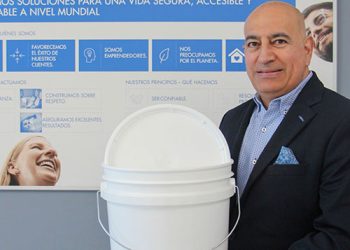The recently published “EU Bioeconomy Strategy Progress Report” presents the state of play of the implementation of the 2018 updated Bioeconomy Strategy and Action Plan and the overall progress of the bioeconomy in Europe.
In the report the Commission concludes that the actions are well on track and already contributed to the objectives of the Green Deal, namely for Europe to become climate neutral by 2050: “With our current fossil-based economy having reached its limits, the transition towards a new societal and economic model, based on the sustainable and circular use of biological resources, has become one of the Union’s core tasks.”
Bio-based is generating economic wealth in Europe
The report delivers strong data on the important role of the bioeconomy sectors in generating economic wealth across Europe: The manufacturing of bio-based products provides 7.92 million jobs with a value added of EUR 433 billion in Europe (8.3 % of the European labour force and 4.7 % of its GDP in 2019). Europe’s global market share for bio-based chemicals and materials of about 31% is twice as high as the one of the fossil-based sectors. And the bio-based share of about 3% in EU’s domestic chemical market shows an important growth potential.
With the consumption and demand for bio-based products showing strong progress, one of the highest substitutions of fossil-based by bio-based chemical products has taken place in the field of bio-based polymers and bio-based packaging. Hence, the report acknowledges that bioplastics are an important part of the bioeconomy and will shape the future of the plastics sector. They contribute substantially to achieving the ambitious climate targets as well as socio-economic targets, such as creating more jobs and growth, and fostering vibrant and sustainable rural areas.
Lack of a long-term policy pull
However, the report also confirms that there is still a lack of a comprehensive regulatory policy approach. Coherent, clear, and consistent policy tools are needed to create a long-term pull and leverage for bio-based products.
The current policies and legislative developments support leveraging synergies in bioenergy, but not bio-based materials and products. Yet, creating a level playing field on the market, including appropriate pricing for fossil resources and subsidies for bio-based products will be critical for the bio-based sectors to thrive and continue to invest in research and innovation.
In fact, with the current EU regulatory developments continuing this path, the already overwhelming dominance of fossil-based feedstocks is only further cemented. Additional hurdles also hamper the switch to bio-based products. All this thwarts key principles of the Green Deal, amongst others, the decoupling of economic growth from resource use and the reduction of greenhouse gas emissions. It also questions the EU’s longstanding commitment and financing of R&I on breakthrough innovations of bio-based, biodegradable, and compostable plastics.
Predicted ‘biomass gap’ and pressures on land
With multiple pressures on the agricultural land, the Commission predicts a ‘biomass gap’ of 40-70% by 2050 between supply and demand of biomass for food, materials, and energy. The problem is amplified considering the current crisis following the Russian invasion of Ukraine: “Europe requires to increase its independence on energy and to strengthen food security, without leaving the path towards a sustainable, resilient, and fair economy as outlined by the European Green Deal”.
The EU sources roughly 1 billion tonnes dry matter of biomass per year, most of which is used for food purposes. 80% of the biomass produced for food is destined for animal-based food, while 20% is plant-based food. Most alarmingly, however, is the fact that almost 18% of the biomass destined for food consumption is wasted.
Bioplastics account for just over about 0.01 percent of the global agricultural area that is used to grow food and feed (source: nova Institute & European Bioplastics, 2021). The sheer difference in volume shows that there is no competition between the use of biomass to produce bio-based plastics and the use of biomass for food and feed.
The only way to close the predicted biomass gap is to follow through with the actions and commitments made in the EU Bioeconomy Strategy and to put additional focus on making use of abandoned agricultural land. At the same time, it is essential to shift at large scale to more sustainable consumption patterns and to tackle food waste which remains at alarmingly high levels within the EU.
Level playing field needed
The bioeconomy can only come to its full potential if new technologies are developed to overcome bottlenecks and make biomass production and recycling of bioresources and bionutrients more competitive within a level playing field.
Sustainably, efficiently, and competitively produced and recycled biomass from the agricultural, forestry, and marine sectors, and from waste sources, can contribute significantly to delivering on the EU’s Green Deal. At the same time, delivering on socio‐economic targets, such as creating more jobs and growth and fostering vibrant and sustainable rural areas should not be overlooked. Sustainably produced biomass also helps reduce Europe’s dependence on fossil fuels, while increasing the security of supply also on regional level. In addition, it can enhance biodiversity through sustainable management of land and resources.
In order to fulfil its growth potential, it is important that the bioplastics industry has guaranteed access to competitively priced agricultural feedstock and biomass in sufficient quantities and quality. This requires an integrated EU policy approach towards establishing a level playing field for industrial use of biomass and feedstock for all bio-based industries to ensure the highest value creation and the strongest environmental benefits.
The bioeconomy progress report provides an important review on the European bioeconomy’s current level of development. It acknowledges its huge potential and the important role the bio-based industry, including bioplastics, plays in safeguarding economic prosperity and wealth in the EU. But it also acknowledges their role in addressing environmental challenges and providing viable alternatives to conventional, fossil-based products. The report also identifies areas which still need improvement, especially the regulatory environment to further promote the mobilisation of private and public investment. It also emphasizes the necessity to ensure that successful research results funded with EU budget receive market access. The publication of the report comes right on time, as the European Commission is currently developing a policy framework on bio-based, biodegradable and compostable plastics. It is also revising existing key legislation related to bioplastics, including the Packaging and Packaging Waste Directive and the Waste Framework Directive. Additionally, the Commission has initiated a process following a new approach, the Sustainable Products Initiative, which aims at building sustainability through the entire product lifecycle. It is important that all these policy processes take the report’s finding into consideration and acknowledge the crucial role of bioplastics within a circular economy.
Packaging 360 is a comprehensive knowledge sharing ecosystem for the Indian packaging industry. Our services include an online content platform to deliver news, insights and case studies; organising conferences seminars and customised training; Providing Bespoke Project Consulting, Market Research and Intelligence.







